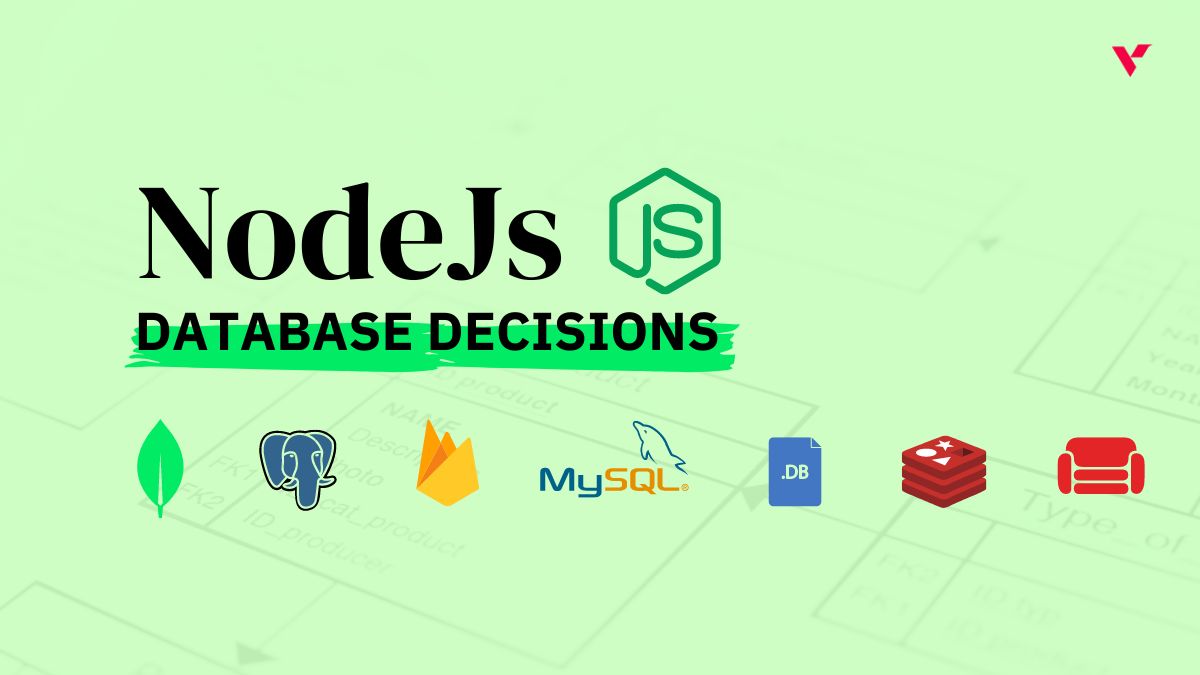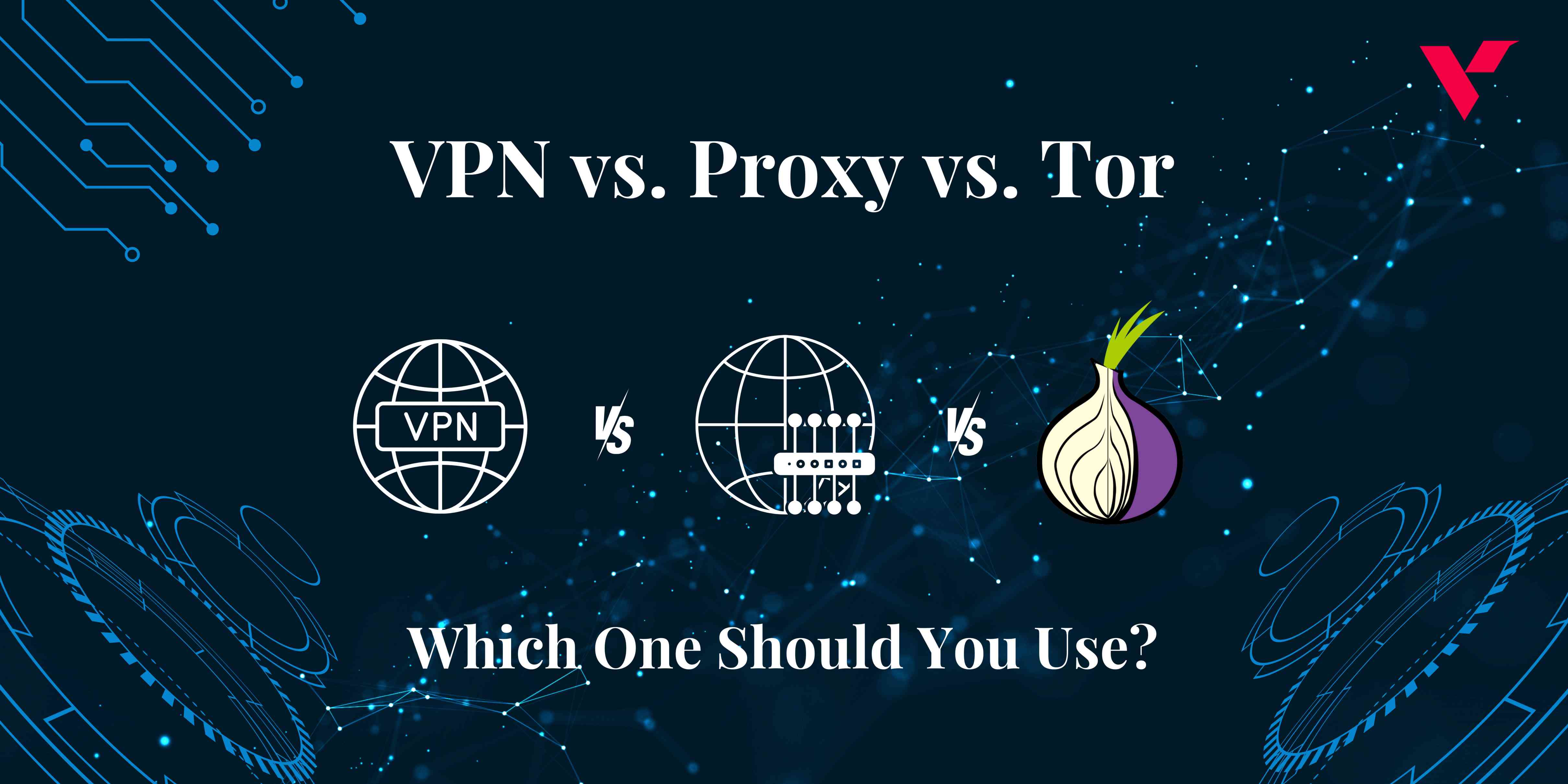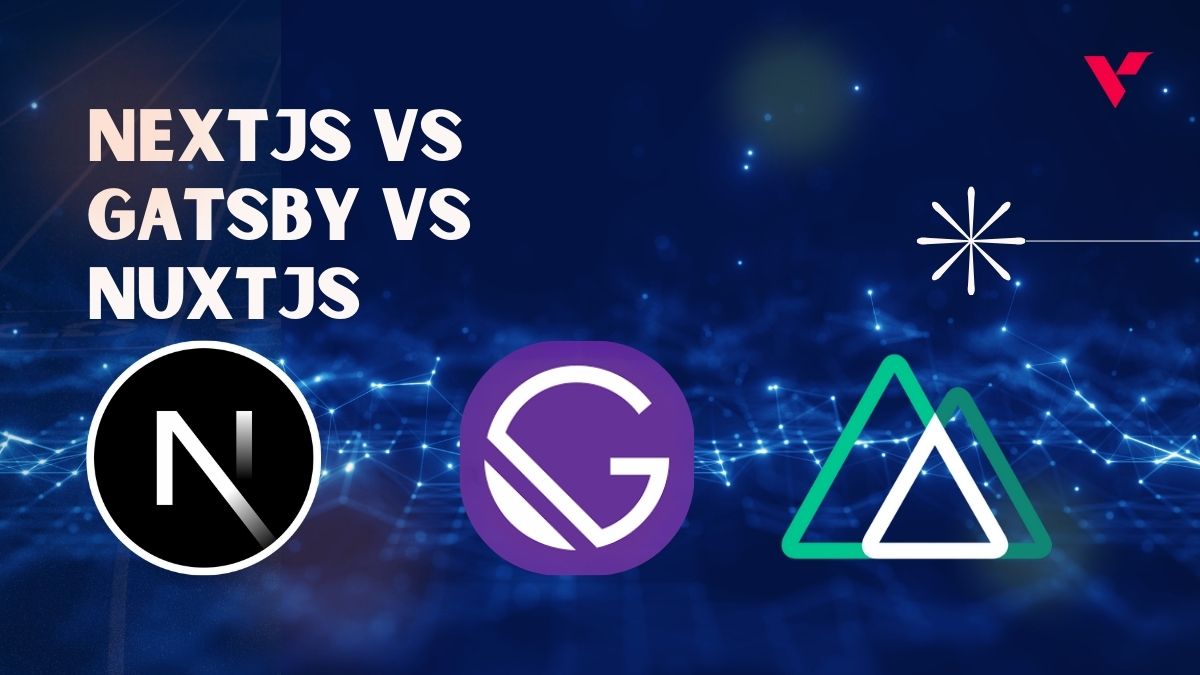Popular Tools by VOCSO
In the evolving landscape of modern application development, selecting the right database for your NodeJS applications is more crucial than ever. As we step into 2024, the choices available are not just numerous but also increasingly sophisticated, catering to a variety of performance, scalability, and operational needs. I aim to uncover the best database options for NodeJS, providing in-depth insights and technical evaluations to help you make informed decisions that align with your development goals and drive your projects to success.
Applications require dealing with both organized and unorganized data structures. You will often find yourself deciding between SQL and NoSQL databases. SQL databases are good for storing structured, relational data efficiently, making them ideal for applications that require complex queries and transactions. They organize data in tables with predefined schemas, ensuring consistency and integrity.
In contrast, NoSQL databases are designed for unstructured or semi-structured data, offering greater flexibility and scalability. You can store data in various formats, such as documents, key-value pairs, or graphs, making them suitable for applications with evolving data requirements and high scalability needs.
Table of Contents
SQL vs NoSQL vs Realtime Databases
Let’s first understand the key differences between SQL, NoSQL, and Real Time databases.
SQL databases like MySQL and PostgreSQL are structured, relational databases, using predefined schemas to ensure data consistency. They specialize in handling complex queries and transactions, making them ideal for applications such as e-commerce platforms that need to manage inventory and customer data.
NoSQL databases like MongoDB and CouchDB offer flexibility and scalability, storing data in formats like documents or key-value pairs. They are suitable for applications with dynamic data needs, such as IoT Data and social media platforms handling diverse user-generated content.
Realtime databases like Firebase Realtime Database provide low-latency data access, allowing instantaneous updates. This is crucial for applications needing real-time collaboration or live updates, such as live chat apps or collaborative editing tools.
SQL vs NoSQL vs Realtime Databases Comparison
| Feature | SQL Databases | NoSQL Databases | Realtime Databases |
| Data Structure | Structured (tables with rows) | Unstructured (documents, key-value pairs, graphs) | Can be structured or unstructured |
| Schema | Fixed schema (predefined data structure) | Flexible schema (data structure can evolve) | Can have schema or schema-less |
| Query Language | Structured Query Language (SQL) | Varies by database type | Can be similar to SQL or use specialized protocols |
| Scalability | Vertical scaling (adding power to existing servers) | Horizontal scaling (adding more servers) | Can scale both vertically and horizontally |
| Data Relationships | Excellent for complex data relationships | Not ideal for complex data relationships | May or may not support complex relationships depending on type |
| Data Updates | Periodic updates | Flexible updates (can be immediate) | Real-time updates |
| Use Cases | Transactional applications, complex queries | Big data, social media, frequent data changes | Stock markets, collaborative editing tools, chat applications |
| Example | Customer database with tables for orders, addresses, etc. | Social media posts with user information, comments, and likes | Stock ticker displaying constantly updating prices |
Best Databases For NodeJS
1. MongoDB
MongoDB stands out as a top choice for NodeJs application development, particularly for those seeking a powerful NoSQL database solution. MongoDB’s document-oriented structure, built on a flexible schema design, allows developers to store data in JSON-like documents. This flexibility is ideal for applications that need to handle a variety of data types and structures without the constraints of a fixed schema imposed by relational databases.
MongoDB’s seamless integration with NodeJs through native drivers like Mongoose makes it incredibly efficient for developers to manage database interactions, ensuring high performance and scalability. This combination of features makes MongoDB a preferred option for real-time analytics, microservices, content management systems, and IoT application backend, where rapid development and adaptability are paramount.
Key Features & Ideal Use Cases of MongoDB
| Key Features | Use Cases |
| Flexible schema for unstructured and semi-structured data (JSON documents) Horizontal scaling by adding more servers (sharding) Rich query language with aggregation capabilities Designed for high performance and availability Real-time analytics and big data solution Seamless Integration with inbuilt driver “Mongoose” | Real-time applications (with additional tools) Microservices Content management systems (CMS) with flexible data structures Social media platforms IoT & Sensor application backend User data management with frequent updates |
Pros & Cons of MongoDB
| Pros | Cons |
| Ideal for rapidly evolving data structures and frequent data changes Scales efficiently for large datasets Easy to integrate with Node.js development Open-source and commercially supported versions available | May not be suitable for complex data relationships Joints between documents can be challenging Requires different query language compared to SQL Data consistency might require more attention |
2. PostgreSQL
PostgreSQL, or Postgres, is a robust, open-source relational database system known for handling complex queries and large datasets. It supports advanced data types, indexing, full-text search, and JSON for semi-structured data. Its extensibility allows for custom functions and data types, including geospatial data through the PostGIS extension. With strong security features and high scalability, Postgres is a preferred choice for both small and large-scale enterprise applications.
PostgreSQL integrates seamlessly with NodeJS, making it an ideal choice for building high-performance web applications that require robust data management and complex querying capabilities.
Key Features & Ideal Use Cases of PostgreSQL
| Key Features | Use Cases |
| Structured data storage Uses SQL for querying and data manipulation ACID properties for data integrity Advanced features like stored procedures, triggers, and user-defined functions | Geospatial applications (using PostGIS extension) Scientific data management Large-scale web applications Real-time analytics (with additional tools) Enterprise applications requiring high data integrity |
Pros & Cons of PostgreSQL
| Pros | Cons |
| Highly customizable and extensible with various extensions Strong focus on data integrity and reliability Excellent performance for complex queries Open-source and community-driven development | Can be more complex to set up and manage compared to MySQL Schema changes can still be cumbersome Horizontal scaling might require additional tools |
3. MySQL
Powering over 40% of the world’s websites, it excels in handling high-traffic applications, but it is ideal for both small and large projects. MySQL is a popular open-source relational database management system known for its speed and reliability. MySQL supports SQL standards, transactions, indexing, and replication, ensuring data integrity and high availability.
It integrates seamlessly with NodeJS and other programming languages, making it versatile for various development environments. Its extensive community support and comprehensive documentation further boost its appeal for developers building scalable web applications.
Tables in MySQL store data in a variety of hidden engines. They do not affect the request’s syntax. The manner the data is written on the disk distinguishes them from one another.
Key Features & Ideal Use Cases of MySQL
| Key Features | Use Cases |
| Structured data storage Uses SQL for querying and data manipulation ACID properties (Atomicity, Consistency, Isolation, Durability) for data integrity Mature and well-supported technology | E-commerce applicationsContent management systems (CMS)Financial applicationsData analytics and reportingInventory management systems |
Pros & Cons of MySQL
| Pros | Cons |
| Excellent for complex queries involving data from multiple tablesStrong data integrity and consistency are a pool of developers familiar with SQLOpen-source and commercially supported versions available | Less flexible for unstructured or semi-structured data schema changes can be complex horizontal scaling can be expensive and not be ideal for real-time updates |
4. SQLite
The database is easily embeddable into applications. Since this system is based on files, it provides a fairly wide range of tools for working with it, compared to network DBMS. When working with this DBMS, requests are made directly to files (where data is stored), instead of ports and sockets in the network DBMS.
SQLite is also very fast and powerful thanks to the serving library technologies. The data storage is that every piece of data is kept on disk, organized into distinct files with unique structures. It can function only and hence is often used in mobile applications.
Key Features & Ideal Use Cases of SQLite
| Key Features | Use Cases |
| Structured data storage uses SQL for querying and data manipulationACID properties for data integrity Lightweight and self-contained (single file database) | Prototyping and development of Mobile AppEmbedded applications Caching data Local storage for desktop applications web applications with low traffic |
Pros & Cons of SQLite
| Pros | Cons |
| Extremely easy to set up and use (no server installation) Zero-configuration and portable (can run on various devices)Ideal for embedded systems or mobile app development Open-source and royalty-free | Limited performance for large datasets and complex queries is not ideal for large-scale, highly concurrent applications scaling is not feasible |
5. Redis
A NoSQL key-value database is called Redis. One important aspect of Redis storage is that it uses RAM to store data. This makes it extremely quick but not very dependable. Redis flushes all data to disk regularly, but it’s prone to data loss in case the server crashes in between adding new data and storing it to disk.
Redis is therefore frequently used as a cache, a session management system, or to solve other issues when data loss isn’t a deal-breaker rather than as the primary storage. It integrates well with NodeJS, enhancing performance for real-time applications.
Key Features & Ideal Use Cases of Redis
| Key Features | Use Cases |
| In-memory data storage for high-performance Key-value storage with various data structures (strings, lists, sets, sorted sets)Pub/Sub messaging for real-time communication data optionally to disk for data recovery | Caching frequently accessed data session management for web applications real-time leaderboards and game mechanicsMessaging queues for task processing high-performance data retrieval applications |
Pros & Cons of Redis
| Pros | Cons |
| Extremely fast read and write speeds ideal for caching and real-time applications simple data model (key-value pairs) Horizontal scaling by adding more serversOpen-source and widely adopted | Data is primarily stored in memory, leading to potential data loss on power outages (requires persistence configuration)Limited querying capabilities compared to SQL or document databases are not ideal for large datasets that don’t benefit from in-memory storage |
6. CouchDB
Unlike traditional relational databases with rigid table structures, CouchDB stores information in flexible JSON documents. This makes it a good fit for data that might change frequently or come in various formats.
CouchDB also shines in terms of scalability, allowing you to easily add more servers to handle growing data volumes. Another advantage is its ability to function offline, making it suitable for mobile applications where internet connectivity might be unreliable like SQLite.
Key Features & Ideal Use Cases of CouchDB
| Key Features | Use Cases |
| Document-oriented NoSQL database stores data in JSON documents with flexible schemas Uses JavaScript as its query language (MapReduce) Offers offline functionality for mobile app development horizontal scaling by adding more servers | Content management systems (CMS) with diverse content types-commerce platforms with evolving product data models Mobile and web applications with user-generated content applications requiring offline data access and synchronizationReal-time applications (with additional tools for updates) |
Pros & Cons of CouchDB
| Pros | Cons |
| Ideal for data that changes frequently or comes in various formats Flexible schema allows for easy evolution of data structures JavaScript query language familiar to Node.js developers Offline functionality for applications requiring data accessibility without internet | May not be suitable for complex data relationships with frequent joinsQuery performance can be slower compared to optimized NoSQL options for specific use cases Less mainstream compared to some NoSQL databases, potentially affecting the developer pool and community resources |
7. Firebase
Firebase is a comprehensive app development platform by Google that includes a real-time NoSQL database known as Firebase Realtime Database. It allows developers to store and sync data across all clients in real time, making it ideal for applications requiring instant updates, such as chat apps, collaborative tools, and live feeds.
Firebase also provides offline support, ensuring that data is available even when the user is not connected to the internet. Its seamless integration with NodeJS and other frameworks simplifies backend development and accelerates the development process. Firebase’s suite of tools, including authentication, cloud storage, and analytics, makes it a popular choice for building scalable and high-performance web and mobile applications.
Firebase lets you send real-time updates through push notifications. By providing pre-built solutions for these common needs, Firebase streamlines development, freeing up developers’ time to focus on what makes their app unique.
Key Features & Ideal Use Cases of Firebase
| Key Features | Use Cases |
| A suite of backend services for mobile and web development offers multiple data storage options: Cloud Firestore (flexible, document-based NoSQL database) and Realtime Database (ideal for real-time data updates) Cloud Storage (for storing images, videos, and other files) Integrates with various Firebase services (authentication, analytics, etc.) | Building real-time chat applications mobile and web apps with user authentication Managing user data and preferencesStoring and serving static content like images and videosPrototyping and building Minimum Viable Products (MVPs) quickly |
Pros & Cons of Firebase
| Pros | Cons |
| Rapid development with pre-built solutions for common needsFlexible data storage options for various use cases real-time data synchronization for collaborative applications easy integration with other Firebase services scalable infrastructure managed by Google | Vendor lock-in compared to self-hosted databasesPricing model for some features and high-traffic applicationsLimited customization compared to standalone databases Requires learning Firebase-specific tools and APIs |
8. Apache Cassandra
A distributed DBMS that is fault-tolerant but not relational is Apache Cassandra. Its purpose was to produce extremely scalable and dependable hash storage for massive volumes of data. Facebook developed the Java-based project in 2008, and in 2009 it was handed to the Apache Software Foundation. This DBMS combines the key-value principle with a ColumnFamily storage model, making it a hybrid NoSQL solution.
Key Features & Ideal Use Cases of Apache Cassandra
| Key Features | Use Cases |
| Distributed NoSQL database for high availability and fault toleranceWide-column store for flexible data structures (rows with columns of various types) Highly scalable by adding more nodes to the cluster offers asynchronous replication for data consistency across multiple data centers | Big data analytics and processing Internet of Things (IoT) data management Social media platforms with high write volume content management systems with massive user-generated content E-commerce applications handling large product catalogs |
Pros & Cons of Apache Cassandra
| Pros | Cons |
| Ideal for handling massive datasets with frequent writes excellent for geographically distributed applications Can handle partial failures without downtimeOpen-source and community-driven development | Complex setup and management compared to other NoSQL options Less suitable for complex data relationshipsQuery language (CQL) requires some adaptation for SQL users data consistency might require tuning depending on the use case |
Key factors to consider when choosing a database for NodeJS
Data Structure and Query Needs:
- SQL Databases: Ideal for structured data with well-defined relationships (think tables with rows). They excel at complex queries that involve joining data from multiple tables.
- NoSQL Databases: More flexible for unstructured or semi-structured data (like documents, key-value pairs, or graphs). They offer simpler queries but may struggle with complex relationships.
- Realtime Databases: Can handle both structured and unstructured data, but prioritize real-time updates for applications requiring constant data flow.
Performance and Scalability:
- SQL Databases: Often perform well for complex read-heavy workloads due to optimized query engines. Scaling can be vertical (adding more power to existing servers) which can be expensive.
- NoSQL Databases: Generally scale horizontally (adding more servers) for massive datasets, making them more cost-effective for large-scale applications.
- Realtime Databases: Optimized for real-time data updates, but may require specific considerations for complex queries or large datasets.
Development Needs and Team Expertise:
- SQL Databases: Commonly used and well-supported, with a large pool of developers familiar with SQL.
- NoSQL Databases: This may require learning a new query language specific to the chosen database type.
- Realtime Databases: Often offer developer-friendly tools and APIs, but expertise in building real-time applications might be beneficial.
Additional Considerations:
- Data Security: All database types offer security features, but research specific options for your needs.
- Cost: Both open-source and paid database solutions exist for each category, consider your budget and long-term needs.
Choosing the Right Database:
There’s no single “best” option. The ideal choice depends on your application’s specific needs. Here’s a general guideline:
- Structured data with complex queries: SQL Databases
- Large, unstructured data with frequent changes: NoSQL Databases
- Real-time data updates as a core functionality: Realtime Databases
At VOCSO, PostgreSQL is our go-to database for various kinds of application development projects. In some applications, we use MySQL and MongoDB as per the need of the project.
Advantages and Disadvantages of SQL Databases
| Feature | Advantage | Disadvantage |
| Data Structure | Ideal for structured data with well-defined relationships, reduces redundancy | Schema rigidity can limit flexibility |
| Development Speed | Mature and well-supported, fast for complex queries | |
| Query Language | Uses standardized SQL | Limited to SQL syntax |
| Query Capability | Excellent for complex queries | |
| Cost Effective | Cost-effective for smaller-scale applications | Vertical scaling can be expensive |
| Technology | Mature and well-supported | |
| Real Time Updates | Not typically optimized for real-time updates | |
| User Experience | Well-understood, many developers familiar with SQL | Less flexibility in handling varying data formats |
| Scalability | Scales vertically by adding server power | Limited horizontal scaling options |
Advantages and Disadvantages of NoSQL Databases
| Feature | Advantage | Disadvantage |
| Data Structure | Flexible for unstructured and semi-structured data | May struggle with complex data relationships |
| Development Speed | Simpler schema design can speed up development | |
| Query Language | Varies between database types | May require learning new query languages |
| Query Capability | Simple queries | May require more effort for complex queries |
| Cost Effective | Horizontal scaling can be cheaper for large datasets | May require more custom development for complex needs |
| Technology | Fast schema design and development | |
| Real Time Updates | Some NoSQL options can handle real-time updates well | Consistency and integrity might require more attention |
| User Experience | Good for applications with dynamic data needs | Learning curve for new query languages |
| Scalability | Scales horizontally by adding more servers | Custom development needed for complex needs |
Advantages and Disadvantages of Real-time Databases
| Feature | Advantage | Disadvantage |
| Data Structure | Can handle both structured and unstructured data, real time data consistency | May not be ideal for complex data relationships |
| Development Speed | Often developer-friendly APIs for real-time features | Requires expertise in building real-time applications |
| Query Language | Developer-friendly APIs | |
| Query Capability | Real-time updates for constant data flow | May not handle complex queries well |
| Cost Effective | Cost-effective for real-time applications | Specialized tools needed for managing real-time updates |
| Technology | Supports real-time features like live chat | Increased complexity for development |
| Real Time Updates | Optimized for real-time data updates | Data consistency might require more effort to maintain |
| User Experience | Enables features like live chat and collaborative editing | Increased complexity compared to traditional databases |
| Scalability | Can scale both vertically and horizontally | Specialized tools needed for real-time scaling |
Conclusion
Picking the perfect database for your NodeJS application isn’t a one-size-fits-all situation. While NodeJS inherently has great bonds with MongoDB. The best choice depends on your project’s specific needs.
If your application deals with structured data and requires complex queries, SQL databases shine with their data integrity and ability to handle intricate searches. This makes them a great fit for tasks like data analysis or reporting.
On the other hand, for applications working with large amounts of unstructured data that changes frequently, NoSQL databases are the way to go. They offer flexibility for various data formats and can easily scale to handle massive datasets.
When real-time updates are the core functionality of your application, look towards real-time databases. These prioritize constant data flow, making them ideal for features like live chat or collaborative editing tools.
You will often end up with a project scenario, where you will need to consider using a combination of these databases, leveraging the strengths of each. The key takeaway is to thoroughly analyze your application’s data structure, scalability needs, real-time requirements, and development complexity. This will equip you to make the most informed decision when choosing the database that best suits your NodeJS project.
FAQs


















